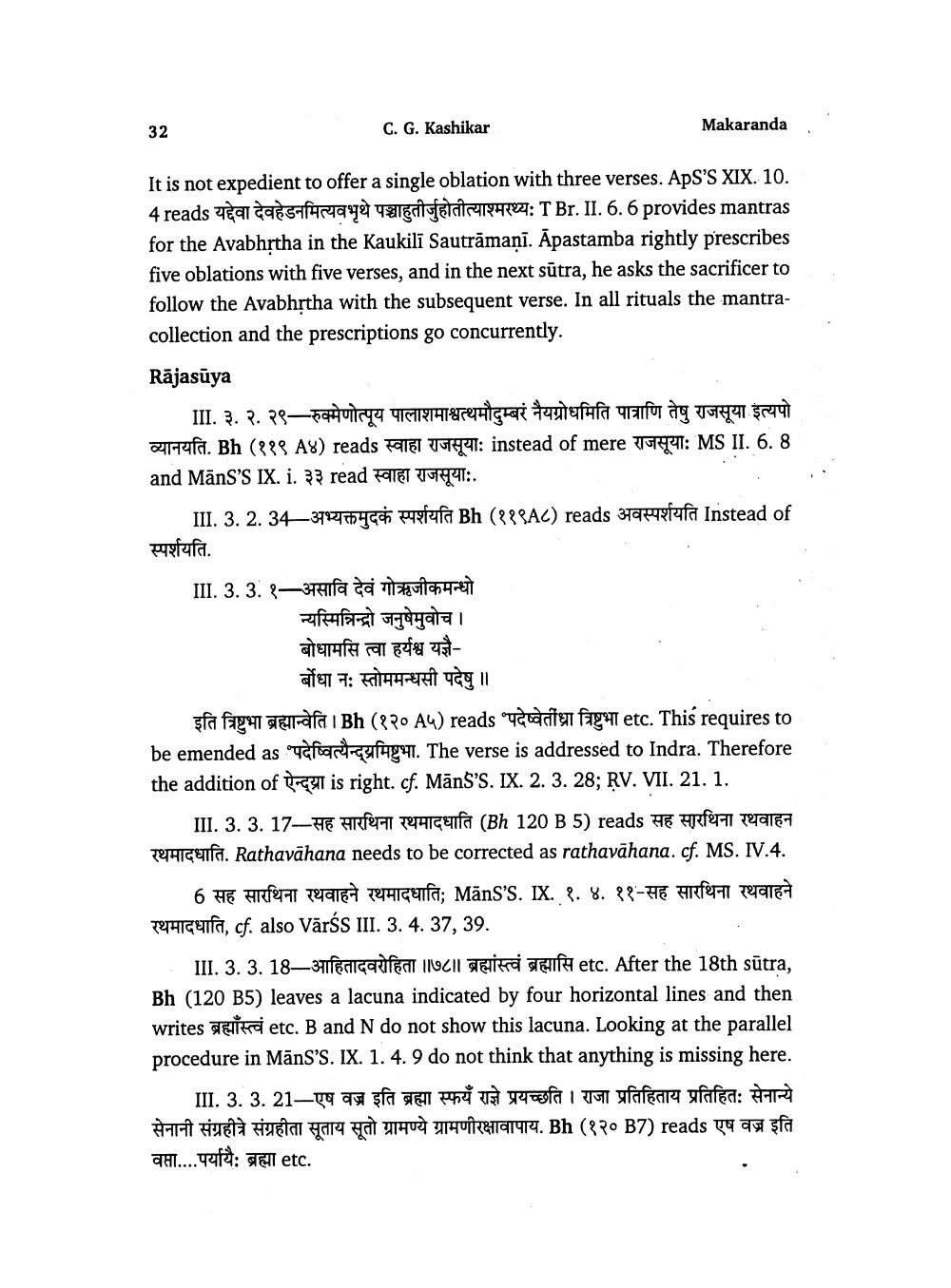________________
32
C. G. Kashikar
Makaranda
It is not expedient to offer a single oblation with three verses. ApS'S XIX. 10. 4 reads यद्देवा देवहेडनमित्यवभृथे पञ्चाहुतीर्जुहोतीत्याश्मरथ्यः T Br. II. 6.6 provides mantras for the Avabhrtha in the Kaukilī Sautrāmaņi. Āpastamba rightly prescribes five oblations with five verses, and in the next sūtra, he asks the sacrificer to follow the Avabhrtha with the subsequent verse. In all rituals the mantracollection and the prescriptions go concurrently. Rājasūya
III. ३. २. २९-रुक्मणोत्पूय पालाशमाश्वत्थमौदुम्बरं नैयग्रोधमिति पात्राणि तेषु राजसूया इत्यपो व्यानयति. Bh (११९ A४) reads स्वाहा राजसूयाः instead of mere राजसूया: MS II. 6. 8 and Mans'S IX. i. ३३ read स्वाहा राजसूया:
III. 3. 2. 34-अभ्यक्तमुदकं स्पर्शयति Bh (११९A८) reads अवस्पर्शयति Instead of स्पर्शयति. III. 3. 3.१-असावि देवं गोऋजीकमन्धो
न्यस्मिन्निन्द्रो जनुषेमुवोच। बोधामसि त्वा हर्यश्व यज्ञै
|धा नः स्तोममन्धसी पदेषु ॥ इति त्रिष्टुभा ब्रह्मान्वेति । Bh (१२० A५) reads पदेष्वेतींध्रा त्रिष्टुभा etc. This requires to be emended as 'पदेष्वित्यैन्यमिष्टुभा. The verse is addressed to Indra. Therefore the addition of ऐन्द्या is right. cf. ManS'S. IX. 2. 3. 28; RV. VII. 21. 1.
III. 3. 3. 17-सह सारथिना रथमादधाति (Bh 120 B5) reads सह सारथिना रथवाहन Theyifa. Rathavāhana needs to be corrected as rathavāhana. cf. MS. IV.4.
6 सह सारथिना रथवाहने रथमादधाति; Mans'S. IX. १. ४. ११-सह सारथिना रथवाहने रथमादधाति, cf. also Varss III. 3. 4. 37, 39.
III. 3. 3. 18-आहितादवरोहिता ।।७८॥ ब्रह्मास्त्वं ब्रह्मासि etc. After the 18th sutra, Bh (120 B5) leaves a lacuna indicated by four horizontal lines and then writes mer etc. B and N do not show this lacuna. Looking at the parallel procedure in MānS'S. IX. 1. 4. 9 do not think that anything is missing here.
III. 3. 3. 21-एष वज्र इति ब्रह्मा स्फयँ राज्ञे प्रयच्छति । राजा प्रतिहिताय प्रतिहितः सेनान्ये सेनानी संग्रहीत्रे संग्रहीता सूताय सूतो ग्रामण्ये ग्रामणीरक्षावापाय. Bh (१२० B7) reads एष वज्र इति वप्ता....पर्यायैः ब्रह्मा etc.




